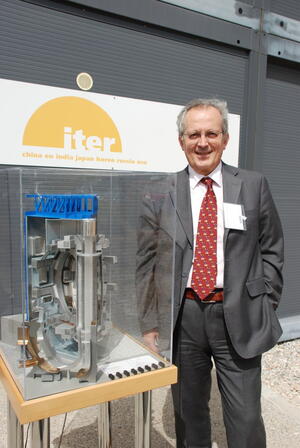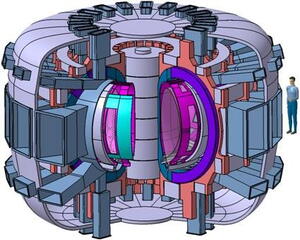FAST—a satellite tokamak for ITER exploitation
This week, Aldo Pizzuto and Flavio Criscanti from the ENEA Research Centre in Frascati, Italy, came to Cadarache to introduce FAST, a European proposal for a new tokamak. FAST ( for Fusion Advanced Studies Torus) is conceived as an ITER satellite complementing the capabilities and missions of the Japanese JT60-SA tokamak. We talked to Aldo Pizzuto, the Head of the Italian Research Facility, about the concept of this proposed project.
ITER: M. Pizzuto, what is FAST and what are the project's main features?
Pizzuto: FAST is an experiment conceived to exploit in a fairly integrated fashion the physics and operating conditions relevant for ITER as well for the projected demonstration fusion power plant DEMO. The FAST plasma has been scaled from that of ITER, thus preserving its adimensional parameters and allowing it to reproduce all the main ITER operating conditions. FAST would have substantial steady state regime capability, with the possibility of operating for 170 seconds in fully non-inductive current drive.
ITER: The project is being presented as a European proposal, but it is being promoted by Italy. Who stands behind this proposal?
Pizzuto: The proposal was initiated by the Italian fusion community, i.e., ENEA, CNR, CRFX and several Universities, but the proposal is for a European satellite tokamak experiment.
ITER: Why do we need a satellite tokamak to ITER? What complementary R&D could we do with FAST that could not be done in other facilities?
Pizzuto: FAST is a deuterium-deuteurium (D-D) experiment and is consequently much more flexible than a nuclear machine like ITER. FAST represents a valuable test bed for ITER, because it will enable the most challenging ITER scenarios. In particular, scenarios for plasma power handling, Edge Localized Mode (ELM) behaviour, disruption mitigations and control. In fact FAST has the same specific power as ITER (i.e. the same heat load at the divertor target plates) and a very similar plasma edge as well as the same plasma equilibria. Furthermore, the integrated approach allows us to study the fast particle dynamics up to DEMO-relevant conditions. Another important target of FAST is to develop innovative plasma wall materials (e.g., liquid lithium) in view of reactor applications.
ITER: What is the schedule? How fast could it be built?
Pizzuto: FAST can be built within seven years including a commissioning period of one year. The next step is to bring it to the group established in Europe to define the scientific objectives for a satellite project.
ITER: Where would FAST be built?
Pizzuto: We analyzed a few sites, but for the time being Frascati is the reference site.
ITER: Talking about money, how much will FAST cost and who is going to pay for it?
Pizzuto: The investment cost for FAST is approximately EUR 300 million plus about EUR 50 million for infrastructure. It is assumed that Italy would contribute up to 60 percent and the remaining 40 percent would be provided by Europe. In-kind contributions from other European countries are being looked at also.
ITER: Is it a good time to come up with a proposal for a satellite tokamak when ITER is faced with increasing costs?
Pizzuto: A robust accompanying program is essential for Europe to play a significant role in the ITER exploitation. In this context the need for a satellite is very much relevant and FAST can be a very good solution at a reasonable cost.



